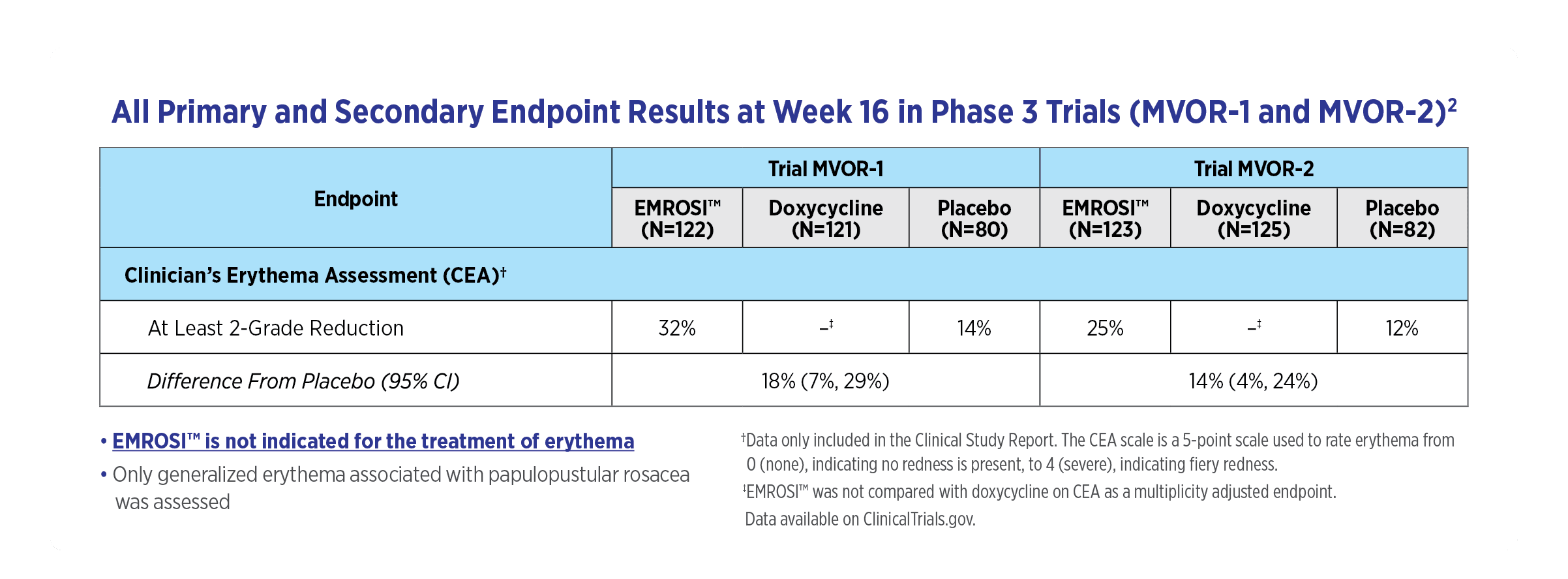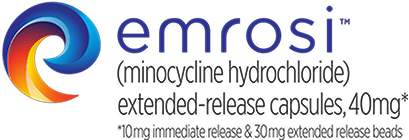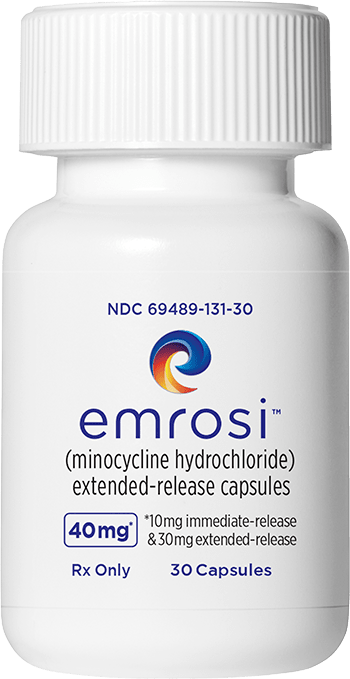INDICATION AND USAGE
EMROSI is a tetracycline-class drug indicated to treat inflammatory lesions (papules and pustules) of rosacea in adults.
Limitations of Use: This formulation of minocycline has not been evaluated in the treatment or prevention of infections. To reduce the development of drug-resistant bacteria and to maintain the effectiveness of other antibacterial drugs, use EMROSI only as indicated.
IMPORTANT SAFETY INFORMATION
Contraindications: EMROSI is contraindicated in patients with a known hypersensitivity to any of the tetracyclines.
WARNINGS AND PRECAUTIONS
Hypersensitivity Reaction and Serious Skin Reactions: Cases of anaphylaxis, serious skin reactions (e.g., Stevens-Johnson syndrome), erythema multiforme, and drug rash with eosinophilia and systemic symptoms (DRESS) syndrome have been reported postmarketing with minocycline use in patients with acne. DRESS syndrome consists of cutaneous reaction (such as rash or exfoliative dermatitis), eosinophilia, and one or more of the following visceral complications such as: hepatitis, pneumonitis, nephritis, myocarditis, and pericarditis. Fever and lymphadenopathy may be present. In some cases, death has been reported. If this syndrome is recognized, discontinue EMROSI immediately.
Tooth Discoloration and Enamel Hypoplasia: The use of EMROSI during tooth development (second and third trimesters of pregnancy, infancy, and childhood up to the age of 8 years) may cause permanent discoloration of the teeth (yellow-gray-brown).
Inhibition of Bone Growth: The use of EMROSI during the second and third trimesters of pregnancy, infancy, and childhood up to the age of 8 years may cause reversible inhibition of bone growth.
Clostridioides difficile-Associated Diarrhea (Antibiotic-Associated Colitis): Discontinue EMROSI if Clostridioides difficile-associated diarrhea (antibiotic-associated colitis) occurs.
Hepatotoxicity: Postmarketing cases of serious liver injury, including irreversible drug-induced hepatitis and fulminant hepatic failure (sometimes fatal) have been reported with minocycline use in the treatment of acne. Discontinue EMROSI if liver injury is suspected.
Central Nervous System Effects: Central nervous system side effects including light-headedness, dizziness or vertigo have been reported with minocycline therapy. Caution patients who experience these symptoms about driving vehicles or using hazardous machinery while on EMROSI. These symptoms may disappear during therapy and usually rapidly disappear when the drug is discontinued.
Idiopathic Intracranial Hypertension: Clinical manifestations of idiopathic intracranial hypertension include headache, blurred vision, diplopia, and vision loss; papilledema can be found on fundoscopy. Women of childbearing age who are overweight or have a history of idiopathic intracranial hypertension are at a greater risk for developing idiopathic intracranial hypertension. Avoid concomitant use of isotretinoin and EMROSI because isotretinoin, a systemic retinoid, is also known to cause idiopathic intracranial hypertension. Permanent visual loss may exist, even after the medication is discontinued. If visual disturbance occurs during treatment, prompt ophthalmologic evaluation is warranted. Because intracranial pressure can remain elevated for weeks after drug cessation, monitor patients until they stabilize.
Autoimmune Syndromes: Tetracyclines have been associated with the development of autoimmune syndromes. The long-term use of minocycline in the treatment of acne has been associated with drug-induced lupus-like syndrome, autoimmune hepatitis and vasculitis. Sporadic cases of serum sickness have presented shortly after minocycline use. Symptoms may be manifested by fever, rash, arthralgia, and malaise. If symptoms occur, immediately discontinue EMROSI.
Metabolic Effects: The anti-anabolic action of the tetracyclines, including EMROSI, may cause an increase in blood urea nitrogen (BUN). If renal impairment exists, monitor serum levels of EMROSI during treatment, and discontinue EMROSI if necessary.
Photosensitivity: Photosensitivity manifested by an exaggerated sunburn reaction has been observed in some individuals taking tetracyclines, including minocycline. Advise patients to minimize or avoid exposure to natural or artificial sunlight (tanning beds or UVA/B treatment) while using EMROSI.
Tissue Hyperpigmentation: Tetracycline-class antibiotics are known to cause hyperpigmentation. EMROSI may induce hyperpigmentation in many organs, including nails, bone, skin, eyes, thyroid, visceral tissue, oral cavity (teeth, mucosa, alveolar bone), sclerae and heart valves. Skin and oral pigmentation has been reported to occur independently of time or amount of drug administration, whereas other tissue pigmentation has been reported to occur upon prolonged administration.
ADVERSE REACTIONS
In patients using EMROSI, the most commonly observed adverse reaction (incidence ≥1%) is dyspepsia.
DRUG INTERACTIONS
Patients who are on anticoagulant therapy may require downward adjustment of their anticoagulant dosage while taking EMROSI.
USE IN SPECIFIC POPULATIONS
Pregnancy: A few postmarketing cases of limb reductions have been reported over decades of use; however, the association is unclear. The limited data from postmarketing reports are not sufficient to inform a drug-associated risk for birth defects or miscarriage. If the patient becomes pregnant while taking EMROSI, advise the patient of the risk to the fetus and discontinue treatment.
Lactation: Breastfeeding is not recommended during EMROSI therapy and for 4 days after the final dose.
To report SUSPECTED ADVERSE REACTIONS, contact Journey Medical Corporation at 1-855-531-1859 or FDA at 1-800-FDA-1088 or www.fda.gov/medwatch.
Please see full Prescribing Information.


